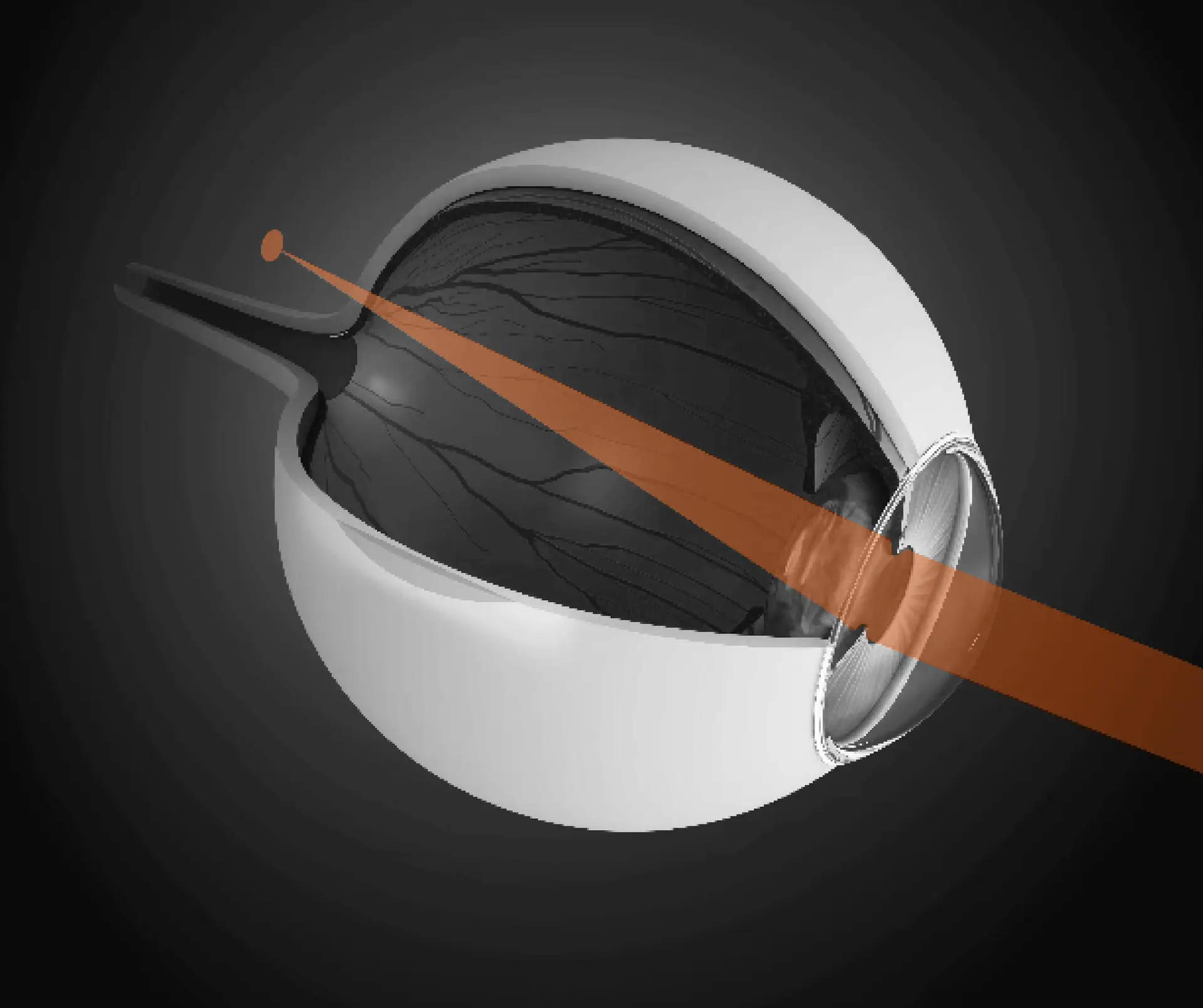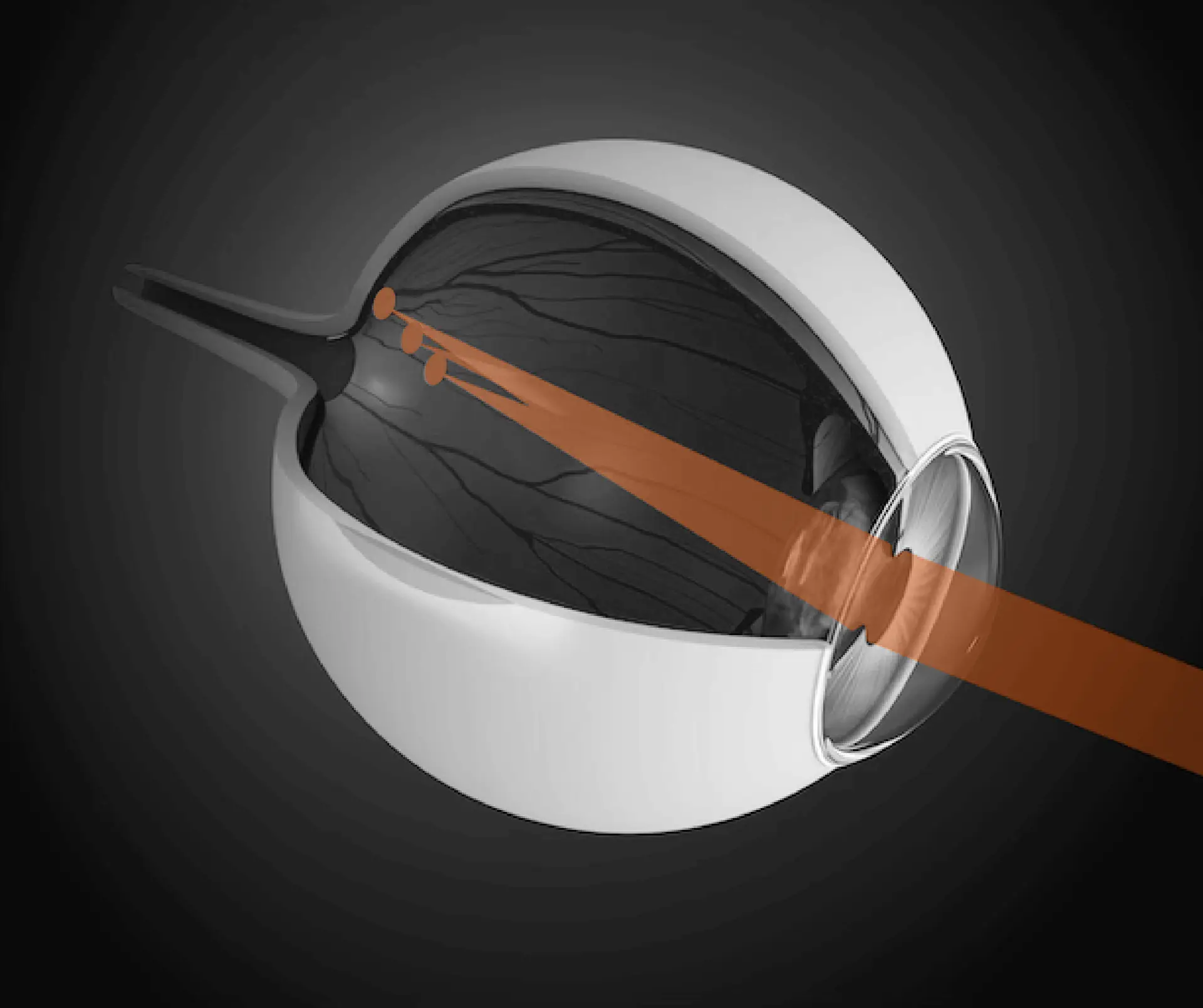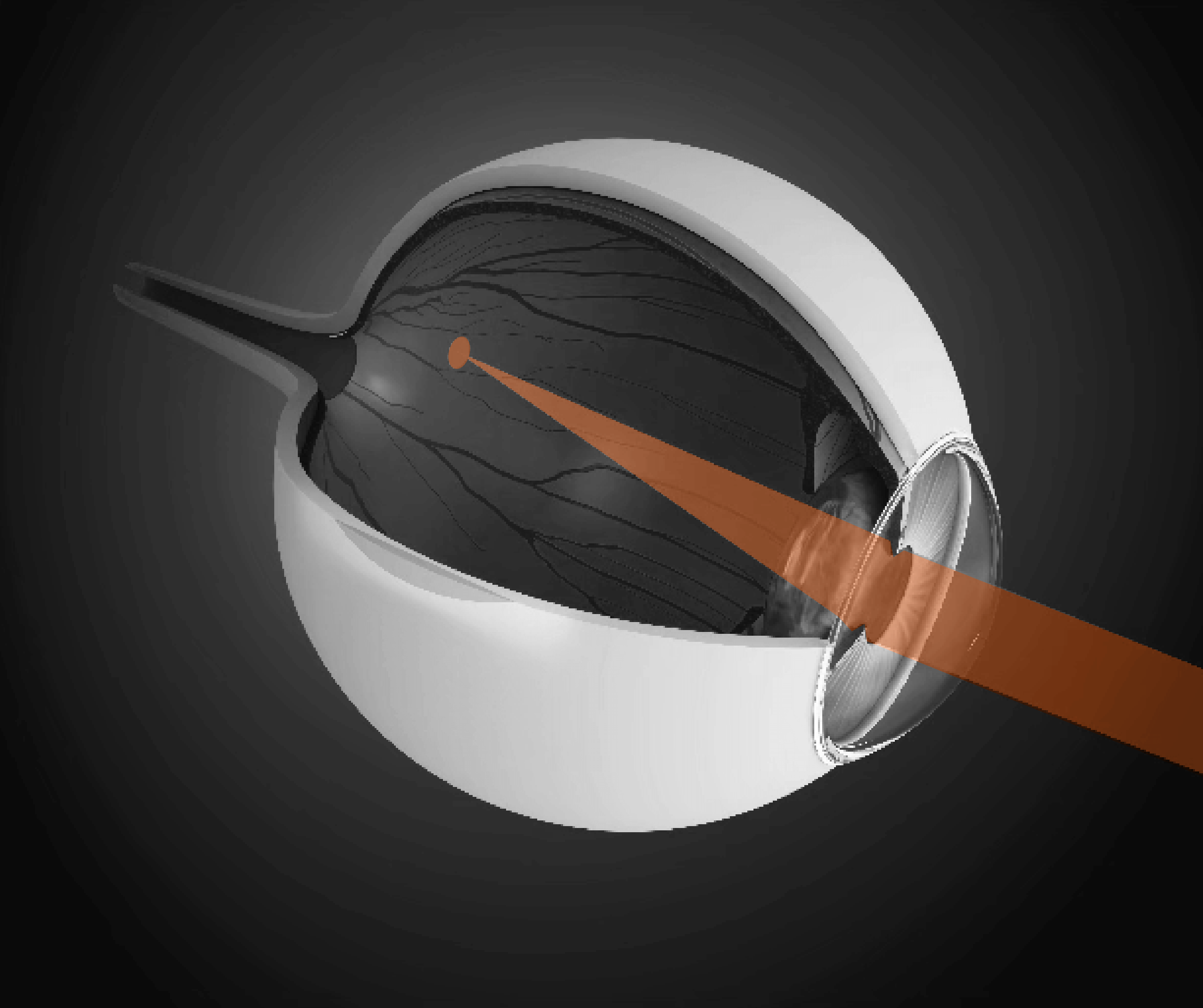For individuals with high prescriptions or who do not qualify for LASIK or other laser vision correction procedures, Implantable Contact Lenses (ICL) may be the solution.
ICLs function much like permanent contact lenses, placed inside the eye rather than on its surface. They are implanted in addition to your natural lens, providing a long-lasting alternative for correcting refractive errors. If you’ve been searching for a way to achieve crisp, clear vision without relying on glasses or contact lenses, ICLs may be your answer.
Conditions ICL’s can correct

Myopia (Nearsightedness)
- Difficulty seeing distant objects
- Up to -20D

Hyperopia (Farsightedness)
- Difficulty seeing close objects
- Up to +10D

Astigmatism
- Blurry vision due to an irregularly shaped cornea
- Up to 6D with Toric ICLs, which correct both astigmatism and other refractive errors

Presbyopia (Age-related vision changes)
- Presbyopic ICLs correct presbyopia along with other refractive errors
Who is a candidate for ICL implant surgery?
ICL surgery may be suitable for individuals who:
- Have high refractive errors not suitable for LASIK or PRK
- Desire a reversible vision correction option
- Prefer not to wear glasses or contact lenses daily
- Are aged 18-55, depending on their refractive needs
- Do not have cataracts or other significant eye health issues
How ICL implant surgery works | Step by step

1. Detailed Eye Scans and Customised Lens Calculation
- Your surgeon will begin by taking detailed scans of your eye to assess your unique anatomy and refractive error.
- This precise information is essential to calculate the perfect lens power needed to correct your vision.
- Once the optimal lens is determined, it will be custom-ordered, which may take a few weeks to arrive.

2. Sedation and Anaesthetic Drops
- ICL surgery is performed in a hospital theatre setting to ensure safety and precision.
- Typically, both eyes are treated on the same day to reduce downtime and achieve consistent vision correction.
- Your anaesthetist will administer sedation to help you relax, and numbing eye drops will be applied to eliminate discomfort during the procedure.
- A gentle eyelid holder will be used to prevent blinking and keep your eye comfortably open.

3. Creating the Incision
- Your surgeon will make a tiny, self-sealing incision in the cornea, approximately 3 mm in size.
- This small incision allows for a quick and uncomplicated healing process.
- The incision is designed to be self-sealing, meaning no sutures are typically required.

4. Inserting the ICL
- The ICL, which is folded for easy insertion, is gently injected through the small corneal incision.

4. Lens is centered to final position
- Once inside the eye, the lens unfolds naturally and is carefully positioned behind the iris and in front of your natural lens.
- The surgeon will ensure the ICL is correctly centred to optimise your vision.
Vision After ICL Surgery
- In the first few days after surgery, it is normal to experience some blurry vision, mild discomfort, and light sensitivity.
- During the first week, your vision will begin to stabilise, and any discomfort or light sensitivity will gradually decrease.
- Over the first month, your vision will continue to improve significantly, with a noticeable enhancement in visual acuity.
- While initial recovery is relatively quick, it may take a few months for your vision to fully stabilise as your eyes adjust to the implanted lenses.
What about ICL’s for presbyopia?
Traditionally, presbyopia has been managed with reading glasses or multifocal lenses. However, for those who prefer a long-term solution, Presbyopic ICLs offer a modern, effective alternative.
Presbyopic ICLs are specially designed to correct near vision issues while also addressing other refractive errors such as myopia or astigmatism. These lenses provide a comprehensive vision solution that allows patients to see both near and distant objects clearly.
The key benefits of Presbyopic ICLs include:
- Multifunctional Vision Correction: Corrects presbyopia along with other refractive errors, reducing or eliminating the need for bifocal or multifocal glasses.
- Natural Visual Experience: The lens sits behind the iris, maintaining a natural appearance without visible lens edges.
- Reversibility and Adaptability: If your vision needs change over time, the lens can be removed or replaced.
- Reduced Dependence on Reading Glasses: Ideal for patients who want more visual freedom.
Presbyopic ICLs are an excellent option for those looking to achieve clear vision at all distances while minimising dependence on reading glasses.
What about ICL’s for astigmatism?
Astigmatism occurs when the cornea or lens has an irregular shape, causing blurred or distorted vision at all distances. Patients with significant astigmatism often struggle to achieve clear vision with glasses or standard contact lenses alone. Toric ICLs offer a long-lasting, effective solution by addressing both astigmatism and other refractive errors in a single procedure.
Toric ICLs are uniquely designed with two primary corrective functions:
- Astigmatism Correction: The lens features a toric design, which compensates for the uneven curvature of the cornea or lens, restoring clear, sharp vision.
- Refractive Error Correction: In addition to astigmatism, Toric ICLs can correct myopia or hyperopia, making them suitable for patients with complex vision needs.
Key advantages of Toric ICLs include:
- Customised Vision Correction: Tailored to each patient’s specific prescription, including both astigmatic and spherical errors.
- Stable and Consistent Vision: Unlike some corrective lenses that can shift or rotate, Toric ICLs are designed to remain securely positioned behind the iris.
- Enhanced Night Vision: Reduced glare and halos compared to some other refractive procedures, which is particularly beneficial for night driving.
- Minimal Maintenance: Unlike traditional toric contact lenses that require daily care, Toric ICLs are implanted once and do not require regular replacement.
Toric ICLs are an excellent choice for individuals with moderate to high astigmatism who are seeking long-lasting vision correction and wish to reduce their dependence on glasses or contact lenses.
Why Choose Sandton Eye Clinic for ICL implants?
- Expert Refractive Surgeons – Internationally qualified and experienced refractive surgeons dedicated to patient care.
- Personalised Care: Tailored treatment plans to meet your unique vision needs.
- Comprehensive Aftercare: Follow-up support to ensure your vision remains optimal.
- High Patient Satisfaction: Thousands of successful procedures and life-changing results.
FAQs
Everything you need to know about Implantable Contact Lenses.
LONGEVITY
How long do ICL implants last? Will my eyesight deteriorate again later in life?
ICL lenses can theoretically remain inside the eye indefinitely.
However, as part of the natural aging process, vision changes may still occur:
- Around age 45, presbyopia (difficulty seeing up close) develops, affecting everyone, whether they had ICL implants or not. If reading glasses become necessary, you may consider Presbyopic ICL’s to help restore near vision.
- By age 60-65, many people develop cataracts, affecting vision clarity. At this stage your ICL will have to be removed, cataract surgery with premium multifocal lenses can restore both near and distance vision.
I had ICL implants years ago. Can I get the procedure again?
If you do need corrective eyewear again years after ICL surgery your surgeon may consider 2 options: a small refractive error may be treated with a simple laser vision correction procedure. The alternative will be replacing the ICL
For patients over 40, near vision changes are usually due to presbyopia and a Presbyopic ICL may be suggested.
When cataracts develop around age 60 your ICL will be removed prior to Refractive cataract surgery.
SAFETY & RISKS
How do you choose an ICL surgeon?
Selecting the right refractive surgeon is one of the most crucial steps in your vision correction journey. Since ICL surgery demands precision and expertise, achieving the best possible outcome relies on choosing a surgeon who possesses both skill and experience.
An exceptional refractive surgeon does more than just perform a procedure—they enhance lives by helping patients achieve clear, unaided vision. Their expertise is not merely an advantage—it is an essential factor in ensuring a successful and safe surgery.
Key Factors to Consider When Choosing an ICL Surgeon:
- Experience & Training – Look for a surgeon with specialised training in refractive surgery and extensive experience specifically in ICL procedures. Surgeons who regularly perform ICL surgeries are more likely to deliver consistent, successful outcomes.
- Proven Success Record – Ask about their visual outcome statistics and patient satisfaction rates. A reputable surgeon will be transparent about their success rates and share data on how their patients' vision improved after surgery.
- Patient Reviews & Testimonials – Read about real patient experiences to gain insight into their care and results.
- Personalized Approach – A great surgeon takes the time to evaluate your unique vision needs and discuss the best options for you.
Choosing a highly qualified ICL surgeon means investing in your visual future. Take the time to research your options, ask questions, and ensure that your chosen surgeon prioritises your individual needs and long-term vision goals.
Does ICL surgery hurt?
ICL surgery is generally painless, thanks to the use of sedation and numbing eye drops. Most patients are sedated to the point where they do not remember the surgery, and local anaesthetic drops are applied to the eyes to ensure a completely pain-free experience during the procedure.
What to Expect During Surgery:
- You will receive a mild sedative to help you feel relaxed and comfortable.
- Anaesthetic eye drops are applied to numb the eye, eliminating any sensation of pain.
- A small, gentle eyelid holder will be placed to keep your eye open, preventing blinking throughout the procedure.
- Your refractive surgeon will make a tiny, self-sealing incision (approximately 3 mm) in the cornea to insert the ICL.
- Once the ICL is positioned correctly, the incision seals naturally without the need for stitches.
After the Procedure:
- You may experience mild discomfort, light sensitivity, or a feeling of grittiness as the numbing drops wear off.
- Some patients may experience a headache due to temporary increased eye pressure. To prevent this, your surgeon will often prescribe medication to reduce pressure and check your eye pressure prior to discharge.
While discomfort is usually minimal and temporary, following your surgeon’s post-operative care instructions will help ensure a smooth and comfortable recovery.
PROCEDURE & CANDIDACY
Can I implant an ICL in only one eye to see how it works?
Typically, ICL surgery is performed on both eyes on the same day. This approach is more convenient for most patients, as it allows for a quicker recovery and more consistent vision correction.
While it is technically possible to implant an ICL in just one eye and wait before addressing the other, this approach is generally not recommended. Here’s why:
- Vision Imbalance: Correcting only one eye can result in a significant difference in vision between the treated and untreated eye. This imbalance, known as anisometropia, can cause discomfort, dizziness, and difficulty with depth perception. Most patients find it challenging to function comfortably with this visual disparity.
- Patient Experience: Since ICLs are designed to provide binocular vision correction, having both eyes treated simultaneously ensures a smoother adaptation and a more immediate sense of visual improvement.
- Efficiency: Performing the procedure on both eyes during the same session reduces the need for multiple hospital visits reducing costs, and minimises disruption to your routine.
If you prefer to have the surgery done one eye at a time, it is possible, but the second procedure is usually scheduled within a week to minimise the discomfort caused by having one eye corrected and the other not.
Choosing to have both ICLs implanted on the same day is generally the best option for achieving balanced, comfortable vision right from the start.
What are the differences between ICL and LASIK?
ICL (Implantable Collamer Lens) and LASIK (Laser-Assisted In Situ Keratomileusis) are both highly effective vision correction procedures, but they work in fundamentally different ways and are suitable for different patient profiles.
ICL (Implantable Collamer Lens):
The ICL is a thin, flexible intraocular lens that is implanted inside the eye without removing the natural lens. This lens is:
- Foldable and Soft: Allows for insertion through a microscopic incision that typically does not require stitches.
- Long-Lasting and Reversible: The ICL can remain in the eye indefinitely but can also be removed or replaced if vision needs change.
- Cornea-Sparing: Since it is placed behind the iris and in front of the natural lens, it does not alter the natural shape or health of the cornea.
- Ideal for High Prescriptions or Thin Corneas: Especially beneficial for patients who are not suitable for LASIK due to thin corneas or high refractive errors.
- No Corneal Tissue Removal: The ICL preserves corneal curvature, making it an excellent option for those who wish to maintain the natural integrity of their cornea.
LASIK (Laser-Assisted In Situ Keratomileusis):
LASIK is a popular laser vision correction procedure that works by reshaping the cornea to improve vision.
- Corneal Reshaping: A laser is used to create a flap in the cornea, which is then lifted so that the underlying corneal tissue can be reshaped with a laser.
- Permanent Correction: The reshaping of the cornea is permanent.
- Quick Visual Recovery: Most patients experience immediate vision improvement, with stabilisation within a few weeks.
- Not Suitable for Everyone: Patients with thin corneas, high prescriptions, or certain eye conditions may not qualify for LASIK.
- Irreversible Corneal Changes: Unlike ICL, once the cornea is reshaped, it cannot be restored to its original form.
Which eye problems can be treated with ICL?
Myopia of up to -20D, Hyperopia of up to +10, Astigmatism of up to 6 and Presbyopia. ICL’s can also treat a combination of the above refractive errors.
Can colored contact lenses be worn after ICL surgery?
Yes, as long as you keep good hygiene colored contact lenses can be worn 1 month after ICL surgery.
POST-PROCEDURE & RECOVERY
What to expect after ICL surgery
Immediately After Surgery:
- No Driving: You will not be able to drive after surgery, so arrange for someone to take you home.
- Rest Your Eyes: Plan to rest and take a nap once you get home to support the healing process.
- Eye Shields: A clear eye shield will be placed over your eyes to protect them and will be removed at your post-op visit.
- Vision Through Shields: Since ICL surgery is typically performed on both eyes on the same day, you will still see through the eye shields immediately after the procedure. Your vision will however be slightly blurred.
Days After Surgery:
- Improved Vision: Vision is usually at about 80% of the expected clarity the day after surgery.
- Gradual Enhancement: Vision will continue to improve over the next 2 days to 1 week.
- Normal Discomfort: It’s common to feel itchiness, especially under the upper eyelid, for a few days. This is a normal part of the healing process.
Weeks After Surgery:
- Gradual Recovery: While recovery varies from person to person, most patients experience progressive improvement over 6 weeks.
- Vision Stabilisation: Adjustments in vision may continue during this period, with full clarity usually achieved by 6 weeks.
- Rest and Protection: Allow your eyes to rest as needed to support healing.
- Sun Protection: Wear UV-protected sunglasses outdoors to reduce light sensitivity.
How soon can I resume daily activities after ICL surgery?
You may be able to resume light daily activities within 24 hours after surgery. However, avoid any strenuous activities, including rigorous exercise and heavy lifting, for at least two weeks to protect your eyes.
When can I start driving again?
Do not drive immediately after surgery. The timeline for resuming driving varies based on your recovery and vision stability. Your ophthalmologist will advise you when it is safe to start driving again.
How can I protect my eyes while sleeping after surgery?
For the first week after surgery, sleep with the clear eye shield provided to prevent accidental rubbing or pressure on your eyes during sleep.
Can I exercise after ICL surgery?
Avoid strenuous exercise, heavy lifting, and high-impact activities for at least two weeks. Light activities, such as walking, can usually be resumed after 24 hours, as advised by your surgeon.
Is it safe to swim after surgery?
Avoid swimming for one month after surgery to reduce the risk of infection. This includes pools, hot tubs, and natural bodies of water.
When can I wear makeup again?
Avoid wearing eye makeup (mascara, eyeliner, eyeshadow) for at least 48 hours after surgery. Your doctor will give you specific guidance on when it is safe to resume.
Can I fly after ICL surgery?
Flying is safe and the only concern would be access to your surgeon should any complication occur. If you plan a trip please discuss it with your surgeon prior to your procedure.
Let Us Help You Take the Next Step
Lorem ipsum dolor sit amet, consectetur adipiscing elit. Ut elit tellus, luctus nec ullamcorper mattis, pulvinar dapibus leo.









